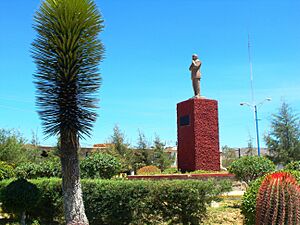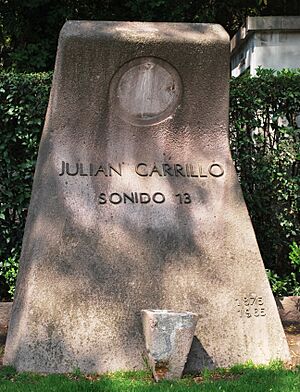Julián Carrillo facts for kids
Julián Carrillo Trujillo (born January 28, 1875 – died September 9, 1965) was a famous Mexican composer, conductor, and violin player. He was also a music theorist, known for creating a special theory of music called "The Thirteenth Sound" (Sonido 13). This theory used musical notes smaller than the usual half-steps.
Contents
Julián Carrillo's Early Life and Music Journey
Julián Carrillo was born on January 28, 1875, in Ahualulco, a small village in San Luis Potosí, Mexico. He was the youngest of 19 children.
Discovering Music in San Luis Potosí
Julián started singing in his church choir in Ahualulco. His choir conductor, Flavio F. Carlos, saw his talent. He encouraged Julián to study music in the state capital, San Luis Potosí City.
In 1885, Julián moved to San Luis Potosí City. He began studying with Flavio F. Carlos. Julián also joined his teacher's orchestra. He first played percussion, then became a violinist.
He wrote his first small pieces for this orchestra. Because his family didn't have much money, Julián left regular school early. But he kept working in the orchestra and studying music.
Studying at the National Conservatory
In 1894, Julián composed a mass, which was a big success locally. This helped him get a recommendation from the government. He was able to go to the National Conservatory of Music in Mexico City.
Julián learned very quickly at the Conservatory. His teachers included Pedro Manzano for violin and Melesio Morales for composition. He also studied physics, acoustics, and math with Francisco Ortega y Fonseca.
Exploring New Sounds: The Thirteenth Sound Idea
Julián was fascinated by how musical sounds work. He learned that pressing a violin string in the middle makes a note an octave higher. Pressing it at one-third makes a perfect fifth higher.
He started experimenting with his violin. He used a razor to divide the fourth string of his violin (between G and A) into sixteen parts. He found he could make sixteen different sounds within just one whole tone.
This discovery led him to study the science and math of music even more. In 1899, the President of Mexico, General Porfirio Díaz, heard Julián play. Díaz was so impressed that he gave Julián a special scholarship to study in Europe.
Julián Carrillo's Studies Abroad
Julián went to the Leipzig Royal Conservatory in Germany. He studied violin, piano, and composition there. He became the first violinist in two orchestras. These were the Conservatory's Orchestra and the famous Gewandhaus Orchestra.
While in Leipzig, he composed several works. These included his Sextet in G Major (1900) and his First Symphony in D Major (1901). He even conducted the premiere of his First Symphony himself.
Sharing Ideas in Paris
In 1900, Julián attended the International Congress of Music in Paris. He presented a paper about naming musical sounds. He suggested that each note should have a single-syllable name. He proposed 35 new names.
After Leipzig, he went to Belgium to improve his violin skills. He studied at the Ghent Royal Conservatory of Music. In 1903, he wrote a Quartet in E minor. He wanted this piece to have "ideological unity" and "tonal variety."
Returning to Mexico with Honors
In 1904, Julián won a top award at the Ghent Conservatory. Later that year, he returned to Mexico. President Díaz gave him a valuable Amati violin as a gift from the Mexican nation.
Back in Mexico City, Julián worked very hard. He was a violinist, conductor, composer, and teacher. He became a professor at the National Conservatory in 1906. He taught history, composition, and orchestration.
Many famous musicians were his students. These included José Francisco Vázquez Cano and Antonio Gómezanda. Julián also formed and conducted the Beethoven Symphony Orchestra (1909). He published books about music, too.
In 1910, he performed his Canto a la Bandera (Song to the Flag). This song has since become an official song for the Mexican Patriot Flag.
Leading the National Conservatory
In 1911, Julián attended music congresses in Rome and London. He presented ideas on how to improve symphonies and military bands. Both congresses approved his ideas.
In 1913, Julián became the Principal of the National Conservatory. He changed the school's curriculum. He focused more on strong musical training, as well as literature and Spanish.
The Birth of "The Thirteenth Sound"
When the government in Mexico changed, Julián had to go to the United States. In New York City, he created and conducted the American Symphony Orchestra. He performed his First Symphony there, which was very successful.
In 1916, Julián composed music for the film Intolerance. While in New York, he also wrote his "Thirteenth Sound Theory." This theory was later published in his book Musical Talks.
Bringing New Music Back to Mexico
In 1918, Julián returned to Mexico. He was chosen to conduct the National Symphony Orchestra (1918–1924). He also became Principal of the National Conservatory again (1920–1921).
Under Julián's leadership, the National Symphony Orchestra became excellent. Famous pianist Leopold Godowsky said it was better than the New York Philharmonic Orchestra. The orchestra became so popular it could support itself.
Julián introduced Mexico to music by famous composers like Bach, Mozart, and Beethoven. He also featured Mexican composers.
The Thirteenth Sound Debate
In 1920, Julián Carrillo explained his Thirteenth Sound Theory to the public. He said that music should use intervals (spaces between notes) smaller than half tones. He showed examples from his early experiments.
Not everyone liked his new theory. Some people, mostly his students, supported it. But others attacked it. They said it was impossible to hear such small intervals. They also claimed Julián had stolen the idea from European musicians.
This led to a big debate called the Thirteenth Sound Polemic. Two groups formed: "Group 9" against Carrillo and "Group 13" supporting him. They argued in newspapers and on the radio.
The debate ended with a concert on February 15, 1925. Group 13 performed Julián's music. They played pieces using quarter-, eighth-, and sixteenth-tones. They used special instruments and trained singers.
Taking the Thirteenth Sound to the World
From September to November 1925, Julián toured Mexico to show off the Thirteenth Sound. In December, he presented it in Havana, Cuba. In 1926, he went to New York City. There, he published a magazine called The Thirteenth Sound.
The League of Composers asked him to write a microtonal piece. He wrote Sonata casi fantasía using quarter-, eighth-, and sixteenth-tones. It was performed in New York in March 1926.
Then, conductor Leopold Stokowski asked Julián for another piece. This was the Concertino, also using microtones. Stokowski and the Philadelphia Symphony Orchestra performed it in New York and Philadelphia.
Julián also wrote Leyes de Metamórfosis Musicales (Musical Metamorphosis Laws). This method showed how to change the tonal proportions of a piece. For example, half tones could become quarter tones.
Challenges and Recognition
When Julián returned to Mexico, his home state of San Luis Potosí honored him. They declared July 13 (the anniversary of his 1895 experiment) as State Day of Honor.
However, Julián didn't get much financial help for his musical revolution. His opponents made it hard for him to work as a conductor or professor. He rarely conducted in Mexico after that. He had to pay for his research and instruments himself.
In 1930, Julián created the Thirteenth Sound Symphony Orchestra. All the instruments in this orchestra could play microtones. From 1930 to 1931, Julián and Leopold Stokowski conducted this orchestra.
In 1930, Julián's Preludio a Colón (Prelude to Christopher Columbus) was recorded. That same year, his hometown of Ahualulco was officially renamed Ahualulco del Sonido 13. He also published books about his musical revolution.
Special Pianos and Musical Physics
In 1940, Julián patented fifteen special "metamorphoser pianos." Each piano could produce different tiny intervals. These pianos had 96 keys, unlike regular pianos.
In 1947, he did experiments at New York University. He showed that the old "node law" in music physics needed to be changed. He explained his ideas in his book Dos leyes de física musical (Two laws of musical physics, 1956).
In 1949, the first metamorphoser piano for third-tones was made. Julián took it to the Paris Musical Conservatory. He met Jean-Étienne Marie, who helped spread Julián's theories in Europe.
Julián gave lectures in France, Spain, and Belgium. In 1951, he held a concert in Mexico City to show his musical metamorphosis laws. That year, Leopold Stokowski performed Julián's Horizontes: Poema sinfónico (Horizons: Symphonic Poem). This piece used quarter-, eighth-, and sixteenth-tones. It was so successful that Stokowski played it again.
In 1954, Julián gave a metamorphoser piano to the Schola Cantorum of Paris. In 1956, France and Germany honored him with important awards. In 1958, Julián showed his 15 metamorphoser pianos at the Brussels' World Exposition. They won a gold medal.
Julián Carrillo's Last Years and Legacy
From 1960 to 1965, Julián recorded about thirty musical works in Paris. He worked with famous French musicians like Jean-Pierre Rampal. These recordings were made by Philips.
In 1960, Julián composed his Canon atonal a 64 voces (Atonal Canon for 64 Voices). He also wrote Balbuceos (Babbles) for metamorphoser piano and orchestra. Leopold Stokowski asked for this last work, and it was performed in Houston.
In 1963, Julián won the Great Award of Latin American Music in Paris. He gave lectures in London and was interviewed by the BBC. The Times newspaper called him "the atom-splitter of music." They said he had "opened a rich emotional world."
In 1964, his First Violin Concerto in quarter-tones was performed for the first time. That year, Julián wrote several more works. These included sonatas for viola and violin in quarter-tones. Mexico's government also gave him a Civic Merit Medal.
In 1965, the USSR invited Julián to perform concerts. He also won the Sibelius Award of Finland. However, he died before he could accept these honors. Julián Carrillo passed away in Mexico City on September 9, 1965. His body was placed in the Rotonda de los Hombres Ilustres (Rotunda of Illustrious Persons) in the Panteón de Dolores cemetery.
See also
 In Spanish: Julián Carrillo para niños
In Spanish: Julián Carrillo para niños



